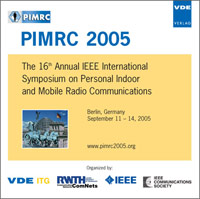WCDMA HSDPA Network Performance with Receive Diversity and LMMSE Chip Equalization
Konferenz: PIMRC 2005 - 16th Annual IEEE International Symposium on Personal Indoor and Mobile Radio Communications
11.09.2005 - 14.09.2005 in Berlin, Germany
Tagungsband: PIMRC 2005
Seiten: 5Sprache: EnglischTyp: PDF
Persönliche VDE-Mitglieder erhalten auf diesen Artikel 10% Rabatt
Autoren:
Nihtilä, Timo; Kurjenniemi, Janne (Department of Mathematical Information Technology, University of Jyväskylä, PO Box 35 (Agora), 40351, Jyväskylä, Finland)
Lampinen, Marko (Nokia, PO Box 50, 90571, Oulu, Finland)
Ristaniemi, Tapani (Institute of Communications Engineering, Tampere University of Technology, PO Box 553, 33101, Tampere, Finland)
Inhalt:
More advanced receiver structures than the conventional single antenna Rake can be used to improve the signal-to-noise (SNR) ratios, which is especially beneficial in order to utilize the high bit rates provided by the HSDPA concept in WCDMA network. In WCDMA system, orthogonal Walsh-Hadamard sequences are used as channelization codes. In frequency-selective fading channels the orthogonality of channelization codes disappears and intra-cell multiple access interference (MAI) arises. In order to mitigate the effect of MAI, a chip-level equalization has shown to be a simple and effective solution. The effectiveness of chip equalization, however, degrades at the cell borders where the inter-cell interference dominates rather than MAI. Dual antenna is a straight-forward solution to mitigate that performance drop. In this paper we consider receivers equipped with dual antenna and Linear Minimum Mean Squared Error (LMMSE) chip-level equalizers and present an analysis of the expected gains over conventional single and dual antenna Rake receivers in realistic situations by using a dynamic WCDMA system-level tool.


